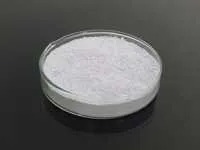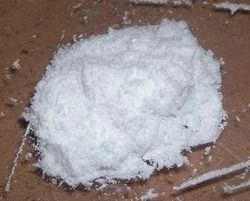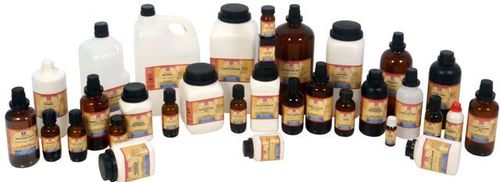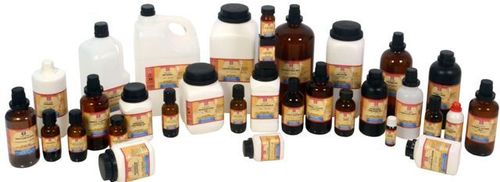Copper(II) acetate monohydrate
Copper(II) acetate monohydrate Specification
- Usage
- Lab Chemicals
- Storage Instructions
- Dry Place
- Grade
- Industrial
- Application
- Lab Chemicals
- Purity(%)
- 99.99
About Copper(II) acetate monohydrate
LC1422 Copper(II) acetate monohydrate for analysis EMSURE Order number Packaging Quantity Price AC28422 Plastic bottle 250 g 38.48 Product information Synonyms Cupric acetate Hill Formula C4H6CuO4 * H2O Chemical formula (CH3COO)2Cu * H2O HS Code 2915 29 00 EC number 205-553-3 Molar mass 199.65 g/mol CAS number 6046-93-1 Chemical and physical data Solubility 72 g/l (20 C) Melting point 115 C Molar mass 199.65 g/mol Density 1.88 g/cm3 (20 C) Bulk density 1100 kg/m3 Boiling point 5.2 - 5.5 (20 g/l, H2O, 20 C) Safety information according to GHS Hazard Statement(s) H302: Harmful if swallowed.H318: Causes serious eye damage.H410: Very toxic to aquatic life with long lasting effects. Precautionary Statement(s) P273: Avoid release to the environment.P305 + P351 + P338: IF IN EYES: Rinse cautiously with water for several minutes. Remove contact lenses, if present and easy to do. Continue rinsing. Signal Word Danger Hazard Pictogram(s) Storage class 10 - 13 Other liquids and solids WGK WGK 3 highly water endangering Disposal 15Heavy metal-containing solutions and solids: container E. Stir Raney nickel (also: Urushibara nickel) in the form of an aqueous suspension into hydrochloric acid (Cat. No. 100312) until dissolved (container E). Neither Raney nickel itself nor any filter residues should be allowed to dry out, otherwise they will spontaneously ignite in air. In this context, heavy metal means any compound of antimony, arsenic, cadmium, chromium(VI), copper, lead, nickel and tin, as well as these subtances in metallic form, if they are classified as hazardous (acc. to AbfallverzeichnisV - Waste Catalogue Ordinance, Appendix 3). Other heavy metals should be collected separately. Safety information R Phrase R 22-41-50/53Harmful if swallowed.Risk of serious damage to eyes.Very toxic to aquatic organisms, may cause long-term adverse effects in the aquatic environment. S Phrase S 26-39-61In case of contact with eyes, rinse immediately with plenty of water and seek medical advice.Wear eye/face protection.Avoid release to the environment. Refer to special instructions/ Safety data sheets. Categories of danger harmful, irritant, dangerous for the environment Hazard Symbol Harmful Dangerous for the environment Transport information Declaration (transport by sea) IMDG-Code UN 3077 ENVIRONMENTALLY HAZARDOUS SUBSTANCE, SOLID, N.O.S.(COPPER(II)-ACETATE), 9, III, Marine Pollutant: P, Segregation Group: 7 (Heavy metals and their salts (including their organometallic compounds)) Declaration (transport by air) IATA-DGR UN 3077 ENVIRONMENTALLY HAZARDOUS SUBSTANCE, SOLID, N.O.S.(COPPER(II)-ACETATE), 9, III Toxicological data LD 50 oral LD50 rat 501 mg/kg Specifications Assay(iodometric) 99.0% Chloride (Cl) 0.001% Sulphate (SO4) 0.005% Total nitrogen (N) 0.01% Ca (Calcium) 0.005% Fe (Iron) 0.002% K (Potassium) 0.01% Na (Sodium) 0.01% Ni (Nickel) 0.002% Pb (Lead) 0.004% Zn (Zinc) 0.002%FAQs of Copper(II) acetate monohydrate:
Q: What is the purity level of Copper(II) acetate monohydrate?
A: The purity level of Copper(II) acetate monohydrate is 99.99%.Q: What grade is Copper(II) acetate monohydrate available in?
A: Copper(II) acetate monohydrate is available in Industrial grade.Q: What are the storage instructions for Copper(II) acetate monohydrate?
A: Copper(II) acetate monohydrate should be stored in a dry place.Q: What is the application of Copper(II) acetate monohydrate?
A: The application of Copper(II) acetate monohydrate is as lab chemicals.Q: Can Copper(II) acetate monohydrate be used in laboratory settings?
A: Yes, Copper(II) acetate monohydrate is specifically intended for use as lab chemicals.

Price:
- 50
- 100
- 200
- 250
- 500
- 1000+
More Products in Laboratory Chemicals Category
LITHIUM AAS STANDARD SOLUTION
Price 553 INR / Kilograms
Minimum Order Quantity : 25gm Kilograms
CAS No : 7439932
Appearance : Clear, colorless liquid
Type : University Lab Chemicals
Purity(%) : 99%
DIPHENYL ACETIC ACID (for synthesis)
Minimum Order Quantity : 25 Gm, Kilograms
CAS No : 117340
Appearance : White crystalline powder
Type : University Lab Chemicals
Purity(%) : 99%
CHES BUFFER
Price 22787 INR / Gram
Minimum Order Quantity : 500 Grams, ,
CAS No : 103479
Appearance : White crystalline powder
Type : Industrial Lab Chemicals
Purity(%) : 99%
iso-BUTYL BENZOATE
Price 4780 INR / Gram
Minimum Order Quantity : 500 Grams, ,
CAS No : 120503
Appearance : Colorless to pale yellow liquid
Type : Other, Aromatic Ester
Purity(%) : 98%
"Only deals in retail accepting orders upto 500ml only".
 |
ALPHA CHEMIKA
All Rights Reserved.(Terms of Use) Developed and Managed by Infocom Network Private Limited. |
 English
English Spanish
Spanish French
French German
German Italian
Italian Chinese (Simplified)
Chinese (Simplified) Japanese
Japanese Korean
Korean Arabic
Arabic Portuguese
Portuguese


 Send Inquiry
Send Inquiry






